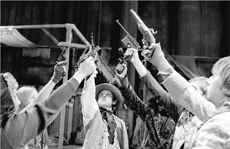The latest film from Dogme is contrived and heavy-handed
Usually, film critics are more reserved and polite than paying audiences. The press screening of “Dear Wendy” I caught was an exception to this rule. A chorus of hisses serenaded the end credits. As I was leaving the building, two strangers struck up conversations with me about how much they hated the film.
Has Danish provocateur Lars von Trier’s satire of American gun culture, helmed by his friend Thomas Vinterberg, hit too close to home? Is this another misunderstood major film?
Alas, “Dear Wendy” really is inane enough to deserve its unwelcoming reception.
The film is set in the small mining town of Estherslope, which revolves around the town square. Dick (Jamie Bell) wants to avoid a life in the mines, where his father died. He buys a secondhand gun, but at first thinks it’s a toy—he bought it for a boy’s birthday party. When he discovers that it’s real, he finally seems to find a place in the town. Although he’s a pacifist, he becomes quite fond of the gun, even naming it Wendy. With other local misfits, he forms a group called the Dandies, who collect antique guns but swear never to draw them or fire at a person. They meet regularly for underground target practice. When a young man on probation for a shooting becomes part of their group, the situation becomes more complicated and dangerous.
If Vinterberg and von Trier had a lighter touch, “Dear Wendy” might have worked. It’s not devoid of wit, particularly in its examination of the Dandies’ rituals. They like watching films about bullet wounds, wearing costumes seemingly lifted from the local community theater’s production of “Annie, Get Your Gun,” and trying to match photos of guns and their owners. However, light is not in their vocabulary. If the Partnership for a Gun-Free America existed, they could use “Dear Wendy” as a feature-length public service announcement. It acknowledges firearms’ seductive power but scoffs at the justification of self-defense—Estherslope’s adults are terrified by a gang that doesn’t really exist. Paranoia about violence becomes a self-fulfilling prophecy.
2005 marks the ten-year anniversary of the Dogme 95 manifesto, devised by Vinterberg, von Trier, and two other Danish filmmakers. This vow of asceticism, which bars the use of sets, artificial lighting, and other decadent crutches may have started as a drunken prank, but it had a major influence on world cinema. The rise of digital video went hand in hand with its aesthetic. Dogme films weren’t required to be shot on DV, but the vast majority were. However, it wouldn’t have amounted to much if it hadn’t produced major films.
Vinterberg’s “The Celebration,” made in 1998, went a long way toward justifying the hype about the empowering nature of both DV and Dogme. After its international success, Vinterberg seemed lost and didn’t make another film for five years. Von Trier’s best work inventively told outlandish religious and political allegories in a style that signified realism. In the press kit for “Dear Wendy,” Vinterberg states, “I have tried, throughout the entire project, to anchor the film in a form of reality and recognizability.”
If that was really his goal, he couldn’t have failed harder. The film’s setting is vague both geographically and temporally. It could be taking place anywhere in the past 40 years in the U.S. Sixties rock band the Zombies dominates the soundtrack. Social critique is easy when you set up straw men and pull their strings at your will.
The tone of “Dear Wendy” is absurdist. It’s a comic version of von Trier’s previous Americana evisceration, “Dogville,” although Vinterberg eschews that film’s minimalism. Unfortunately, for Vinterberg and von Trier, the absurdist sensibility exists in order to justify any ludicrous plot development they can throw at the screen. “Dear Wendy” really starts sinking downhill when Sheriff Krugsby (Bill Pullman) makes Dick the probation officer for Sebastian (Danso Gordon), the troubled grandson of Dick’s late father’s maid. From this point on, events happen because they’ll propel the plot along or make some didactic point, not because these particular characters would logically act that way. Von Trier seems to have researched American life by alternating Michael Moore films and Westerns—though he never learned how to write an interesting shoot-out.
“Dear Wendy” is aiming for a bigger target than making fun of a few gun nuts. The contradictory concept of armed pacifism is a general metaphor for American—and Western—hypocrisy. Theres a worthy film to be made about liberal Americans’ complicity in the proliferation of guns, but this isn’t it. (Ben Coccio’s Columbine-inspired “Zero Day” would be a good starting point.)
To his credit, Vinterberg brings more humanity to the script than von Trier’s own films generally display. “Dear Wendy” is mostly free of the cheap shots that characterized “Dogville” and “Dancer in the Dark,” although Pullman’s performance is embarrassingly cartoonish. The one strength of von Trier’s recent films—his flair for melodrama—is missing here.
In the French magazine “Positif,” critic Gregory Valens wrote his review of “Dear Wendy” in the form of a letter to the filmmakers, asking von Trier whether he was younger or older than 12 when he wrote the script. Valens may be cruel, but he is spot-on. Will von Trier ever make another film as moving as “Breaking the Waves” or as unpretentious and fun as his TV mini-series “The Kingdom?” “Dear Wendy” suggests that he’s sunk from artistry to the easier task of provocation.
gaycitynews.com



































